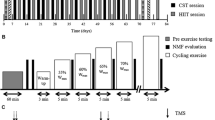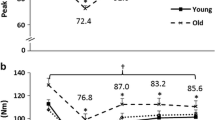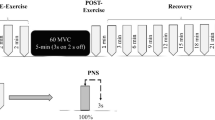Abstract
Purpose
To investigate the relationship between the recovery of neuromuscular fatigue and the recovery of amount of work done above critical power (W´).
Methods
Ten healthy men performed, on different days, constant work rate exercises until task failure to determine critical power (CP) and W´. In the three following visits, participants performed two exhausting constant work rate exercises estimated to induce task failure within 6 min (P61 and P62), interspaced by 3, 6 or 15 min of recovery. Neuromuscular function was assessed before and periodically after the P61 using percutaneous electrical femoral nerve stimulation. The W´ recovery was measured from the total work performed above CP during the P62.
Results
The P61 induced a full use of W´ and a reduction in maximal voluntary contraction (MVC, − 19 ± 4%), voluntary activation (VA, − 6 ± 2%) and twitch force stimulated at 1 Hz (− 37 ± 11%), 10 Hz (− 50 ± 16%) and 100 Hz (− 32 ± 11%), when compared to baseline (P < 0.05). The time constant of VA recovery was significantly faster than the time constant of W´ recovery (P < 0.05), but there was no significant difference between the time constant of W´ recovery and the time constant of recovery of MVC or twitch force stimulated at 1, 10 and 100 Hz (P > 0.05). However, the time constant of W´ recovery was only associated to the time constant of MVC recovery (r = 0.73, P < 0.05).
Conclusion
The W´ recovery is not associated to the recovery of peripheral or central fatigue alone. Rather, W´ seems to be associated to the recovery of the overall capacity to generate force.




Similar content being viewed by others
Abbreviations
- Δ:
-
Work rate difference between GET and the V̇O2max
- AV:
-
Voluntary activation
- ANOVA:
-
Analysis of variance
- Ca2+ :
-
Calcium
- CI:
-
Confidence interval
- CNS:
-
Central nervous system
- CP:
-
Critical power
- EMG:
-
Surface electromyography
- ES:
-
Electrical stimulation
- GET:
-
Gas exchange threshold
- HR:
-
Heart rate
- MVC:
-
Maximal isometric voluntary contraction
- M-wave:
-
Muscle action potential
- PCr:
-
Phosphocreatine
- P6:
-
Exercise intensity estimated to induce task failure within 6 minutes
- Q tw,unpot :
-
Unpotentiated twitch torque
- Q tw,pot :
-
Quadriceps potentiated twitch evoked by single pulse
- Q tw10 :
-
Quadriceps potentiated twitch evoked by paired pulse at 10 Hz
- Q tw100 :
-
Quadriceps potentiated twitch evoked by paired pulse at 100 Hz
- RPE:
-
Rating of perceived exertion
- t 1/2 :
-
Half-time to recovery
- t :
-
Time to task failure
- \(\dot{\mathrm{V}}\)CO2 :
-
Carbon dioxide production
- \(\dot{\mathrm{V}}\)E:
-
Minute ventilation
- \(\dot{\mathrm{V}}\)O2max :
-
Maximal oxygen uptake
- W´:
-
Amount of work done above critical power
References
Arcoverde L, Silveira R, Tomazini F, Sansonio A, Bertuzzi R, Lima-Silva AE (2017) Effect of caffeine ingestion on anaerobic capacity quantified by different methods. PLoS ONE 12(6):e0179457. https://doi.org/10.1371/journal.pone.0179457
Behm DG, St-Pierre DM, Perez D (1996) Muscle inactivation: assessment of interpolated twitch technique. J Appl Physiol 81(5):2267–2273. https://doi.org/10.1152/jappl.1996.81.5.2267
Black MI, Jones AM, Blackwell JR, Bailey SJ, Wylie LJ, McDonagh ST, Thompson C, Kelly J, Sumners P, Mileva KN, Bowtell JL, Vanhatalo A (2017) Muscle metabolic and neuromuscular determinants of fatigue during cycling in different exercise intensity domains. J Appl Physiol 122(3):446–459. https://doi.org/10.1152/japplphysiol.00942.2016
Black MI, Jones AM, Kelly JA, Bailey SJ, Vanhatalo A (2016) The constant work rate critical power protocol overestimates ramp incremental exercise performance. Eur J Appl Physiol 116(11–12):2415–2422. https://doi.org/10.1007/s00421-016-3491-y
Blain GM, Mangum TS, Sidhu SK, Weavil JC, Hureau TJ, Jessop JE, Bledsoe AD, Richardson RS, Amann M (2016) Group III/IV muscle afferents limit the intramuscular metabolic perturbation during whole body exercise in humans. J Physiol 594(18):5303–5315. https://doi.org/10.1113/jp272283
Broxterman RM, Craig JC, Smith JR, Wilcox SL, Jia C, Warren S, Barstow TJ (2015) Influence of blood flow occlusion on the development of peripheral and central fatigue during small muscle mass handgrip exercise. J Physiol 593(17):4043–4054. https://doi.org/10.1113/jp270424
Broxterman RM, Craig JC, Weavil JC, Hureau TJ (2019) The relationship between W' and peripheral fatigue considered. Exp Physiol. https://doi.org/10.1113/ep088239
Broxterman RM, Skiba PF, Craig JC, Wilcox SL, Ade CJ, Barstow TJ (2016) W' expenditure and reconstitution during severe intensity constant power exercise: mechanistic insight into the determinants of W'. Physiol Rep. https://doi.org/10.14814/phy2.12856
Burnley M, Jones AM (2016) Power-duration relationship: Physiology, fatigue, and the limits of human performance. Eur J Sport Sci. https://doi.org/10.1080/17461391.2016.1249524
Cannon DT, Bimson WE, Hampson SA, Bowen TS, Murgatroyd SR, Marwood S, Kemp GJ, Rossiter HB (2014) Skeletal muscle ATP turnover by 31P magnetic resonance spectroscopy during moderate and heavy bilateral knee extension. J Physiol 592(23):5287–5300. https://doi.org/10.1113/jphysiol.2014.279174
Carroll TJ, Taylor JL, Gandevia SC (2017) Recovery of central and peripheral neuromuscular fatigue after exercise. J Appl Physiol 122(5):1068–1076. https://doi.org/10.1152/japplphysiol.00775.2016
Coats EM, Rossiter HB, Day JR, Miura A, Fukuba Y, BJ, Whipp (2003) Intensity-dependent tolerance to exercise after attaining V(O2) max in humans. J Appl Physiol 95(2):483–490. https://doi.org/10.1152/japplphysiol.01142.2002
Craig CL, Marshall AL, Sjostrom M, Bauman AE, Booth ML, Ainsworth BE, Pratt M, Ekelund U, Yngve A, Sallis JF, Oja P (2003) International physical activity questionnaire: 12-country reliability and validity. Med Sci Sports Exerc 35(8):1381–1395. https://doi.org/10.1249/01.Mss.0000078924.61453.Fb
Enoka RM, Stuart DG (1992) Neurobiology of muscle fatigue. J Appl Physiol 72(5):1631–1648. https://doi.org/10.1152/jappl.1992.72.5.1631
Felippe LC, Ferreira GA, Learsi SK, Boari D, Bertuzzi R, Lima-Silva AE (2018) Caffeine increases both total work performed above critical power and peripheral fatigue during a 4-km cycling time trial. J Appl Physiol 124(6):1491–1501. https://doi.org/10.1152/japplphysiol.00930.2017
Ferguson C, Rossiter HB, Whipp BJ, Cathcart AJ, Murgatroyd SR, Ward SA (2010) Effect of recovery duration from prior exhaustive exercise on the parameters of the power-duration relationship. J Appl Physiol 108(4):866–874. https://doi.org/10.1152/japplphysiol.91425.2008
Fernandez-del-Olmo M, Rodriguez FA, Marquez G, Iglesias X, Marina M, Benitez A, Vallejo L, Acero RM (2013) Isometric knee extensor fatigue following a Wingate test: peripheral and central mechanisms. Scand J Med Sci Sports 23(1):57–65. https://doi.org/10.1111/j.1600-0838.2011.01355.x
Fitts RH (1994) Cellular mechanisms of muscle fatigue. Physiol Rev 74(1):49–94. https://doi.org/10.1152/physrev.1994.74.1.49
Froyd C, Millet GY, Noakes TD (2013) The development of peripheral fatigue and short-term recovery during self-paced high-intensity exercise. J Physiol 591(5):1339–1346. https://doi.org/10.1113/jphysiol.2012.245316
Gandevia SC (2001) Spinal and supraspinal factors in human muscle fatigue. Physiol Rev 81(4):1725–1789. https://doi.org/10.1152/physrev.2001.81.4.1725
Gandevia SC, Allen GM, Butler JE, Taylor JL (1996) Supraspinal factors in human muscle fatigue: evidence for suboptimal output from the motor cortex. J Physiol 490(Pt 2):529–536
Greco CC, Carita RA, Dekerle J, Denadai BS (2012) Effect of aerobic training status on both maximal lactate steady state and critical power. Appl Physiol Nutr Metab 37(4):736–743. https://doi.org/10.1139/h2012-047
Gruet M, Temesi J, Rupp T, Levy P, Verges S, Millet GY (2014) Dynamics of corticospinal changes during and after high-intensity quadriceps exercise. Exp Physiol 99(8):1053–1064. https://doi.org/10.1113/expphysiol.2014.078840
Hureau TJ, Ducrocq GP, Blain GM (2016) Peripheral and central fatigue development during all-out repeated cycling sprints. Med Sci Sports Exerc 48(3):391–401. https://doi.org/10.1249/mss.0000000000000800
Jones AM, Wilkerson DP, DiMenna F, Fulford J, Poole DC (2008) Muscle metabolic responses to exercise above and below the "critical power" assessed using 31P-MRS. Am J Physiol Regul Integr Comp Physiol 294(2):R585–593. https://doi.org/10.1152/ajpregu.00731.2007
Kennedy DS, Fitzpatrick SC, Gandevia SC, Taylor JL (2015) Fatigue-related firing of muscle nociceptors reduces voluntary activation of ipsilateral but not contralateral lower limb muscles. J Appl Physiol 118(4):408–418. https://doi.org/10.1152/japplphysiol.00375.2014
Kowalchuk JM, Smith SA, Weening BS, Marsh GD, Paterson DH (2000) Forearm muscle metabolism studied using (31)P-MRS during progressive exercise to fatigue after Acz administration. J Appl Physiol 89(1):200–209. https://doi.org/10.1152/jappl.2000.89.1.200
Layec G, Bringard A, Le Fur Y, Micallef JP, Vilmen C, Perrey S, Cozzone PJ, Bendahan D (2016) Mitochondrial coupling and contractile efficiency in humans with high and low VO2peaks. Med Sci Sports Exerc 48(5):811–821. https://doi.org/10.1249/mss.0000000000000858
Merton PA (1954) Voluntary strength and fatigue. J Physiol 123(3):553–564
Meyer T, Lucia A, Earnest CP, Kindermann W (2005) A conceptual framework for performance diagnosis and training prescription from submaximal gas exchange parameters–theory and application. Int J Sports Med 26(Suppl 1):S38–48. https://doi.org/10.1055/s-2004-830514
Millet GY, Bachasson D, Temesi J, Wuyam B, Feasson L, Verges S, Levy P (2012) Potential interests and limits of magnetic and electrical stimulation techniques to assess neuromuscular fatigue. Neuromuscul Disord 22(Suppl 3):S181–186. https://doi.org/10.1016/j.nmd.2012.10.007
Moritani T, Nagata A, deVries HA, Muro M (1981) Critical power as a measure of physical work capacity and anaerobic threshold. Ergonomics 24(5):339–350. https://doi.org/10.1080/00140138108924856
Poole DC, AM, Jones (2017) Measurement of the maximum oxygen uptake Vo2max: Vo2peak is no longer acceptable. J Appl Physiol 122(4):997–1002. https://doi.org/10.1152/japplphysiol.01063.2016
Ravier G, Dugue B, Grappe F, Rouillon JD (2006) Maximal accumulated oxygen deficit and blood responses of ammonia, lactate and pH after anaerobic test: a comparison between international and national elite karate athletes. Int J Sports Med 27(10):810–817. https://doi.org/10.1055/s-2005-872965
Rodriguez-Falces J, Place N (2016) Differences in the recruitment curves obtained with monopolar and bipolar electrode configurations in the quadriceps femoris. Muscle Nerve 54(1):118–131. https://doi.org/10.1002/mus.25006
Schafer LU, Hayes M, Dekerle J (2018) The magnitude of neuromuscular fatigue is not intensity-dependent when cycling above critical power but relates to aerobic and anaerobic capacities. Exp Physiol. https://doi.org/10.1113/ep087273
Schafer LU, Hayes M, Dekerle J (2019) The magnitude of neuromuscular fatigue is not intensity dependent when cycling above critical power but relates to aerobic and anaerobic capacities. Exp Physiol 104(2):209–219. https://doi.org/10.1113/ep087273
Simmonds MJ, Minahan CL, Sabapathy S (2010) Caffeine improves supramaximal cycling but not the rate of anaerobic energy release. Eur J Appl Physiol 109(2):287–295. https://doi.org/10.1007/s00421-009-1351-8
Skiba PF, Chidnok W, Vanhatalo A, Jones AM (2012) Modeling the expenditure and reconstitution of work capacity above critical power. Med Sci Sports Exerc 44(8):1526–1532. https://doi.org/10.1249/MSS.0b013e3182517a80
Skiba PF, Fulford J, Clarke DC, Vanhatalo A, Jones AM (2015) Intramuscular determinants of the ability to recover work capacity above critical power. Eur J Appl Physiol 115(4):703–713. https://doi.org/10.1007/s00421-014-3050-3
Skiba PF, Jackman S, Clarke D, Vanhatalo A, Jones AM (2014) Effect of work and recovery durations on W' reconstitution during intermittent exercise. Med Sci Sports Exerc 46(7):1433–1440. https://doi.org/10.1249/mss.0000000000000226
Skurvydas A, Brazaitis M, Kamandulis S, Sipaviciene S (2010) Peripheral and central fatigue after muscle-damaging exercise is muscle length dependent and inversely related. J Electromyogr Kinesiol 20(4):655–660. https://doi.org/10.1016/j.jelekin.2010.02.009
Thomas K, Brownstein CG, Dent J, Parker P, Goodall S, Howatson G (2018) Neuromuscular fatigue and recovery after heavy resistance, jump, and sprint training. Med Sci Sports Exerc 50(12):2526–2535. https://doi.org/10.1249/mss.0000000000001733
Thomas K, Elmeua M, Howatson G, Goodall S (2016) Intensity-dependent contribution of neuromuscular fatigue after constant-load cycling. Med Sci Sports Exerc 48(9):1751–1760. https://doi.org/10.1249/mss.0000000000000950
Todd G, Taylor JL, Gandevia SC (2003) Measurement of voluntary activation of fresh and fatigued human muscles using transcranial magnetic stimulation. J Physiol 551(Pt 2):661–671. https://doi.org/10.1113/jphysiol.2003.044099
Tupling R, Green H, Grant S, Burnett M, Ranney D (2000) Postcontractile force depression in humans is associated with an impairment in SR Ca(2+) pump function. Am J Physiol Regul Integr Comp Physiol 278(1):R87–94. https://doi.org/10.1152/ajpregu.2000.278.1.R87
Valentini FA, Nelson PP (1985) Mathematical model of muscular fatigue. II. Changes of metabolites level and of force during exercise in relation to a fatigability parameter. Int J Biomed Comput 17(3–4):197–213. https://doi.org/10.1016/0020-7101(85)90023-6
Vanhatalo A, Black MI, DiMenna FJ, Blackwell JR, Schmidt JF, Thompson C, Wylie LJ, Mohr M, Bangsbo J, Krustrup P, Jones AM (2016) The mechanistic bases of the power-time relationship: muscle metabolic responses and relationships to muscle fibre type. J Physiol 594(15):4407–4423. https://doi.org/10.1113/jp271879
Vanhatalo A, Doust JH, Burnley M (2007) Determination of critical power using a 3-min all-out cycling test. Med Sci Sports Exerc 39(3):548–555. https://doi.org/10.1249/mss.0b013e31802dd3e6
Vernillo G, Temesi J, Martin M, Millet GY (2018) Mechanisms of Fatigue and Recovery in Upper versus Lower Limbs in Men. Med Sci Sports Exerc 50(2):334–343. https://doi.org/10.1249/mss.0000000000001445
Zarzissi S, Zghal F, Bouzid MA, Hureau TJ, Sahli S, Ben Hassen H, Rebai H (2019) Centrally-mediated regulation of peripheral fatigue during knee extensor exercise and consequences on the force-duration relationship in older men. Eur J Sport Sci: https://doi.org/10.1080/17461391.2019.1655099
Acknowledgements
This study was financed in part by the Coordination for the Improvement of Higher Education Personnel-Brazil (CAPES)-Finance Code 001, and an internal Grant from the Research and Graduate Office of Federal University of Pernambuco–Brazil (process Nº 024985/2015-75). Leandro C. Felippe and Guilherme A. Ferreira are grateful to CAPES for scholarships. Marcos D. Silva-Cavalcante is grateful to CAPES for current Post-Doctoral Fellowship (PNPD/CAPES). We also thank Isael João de Lima for his contribution to the paper. The English text of this paper has been revised by Sidney Pratt, Canadian, MAT (The Johns Hopkins University), RSAdip—TESL (Cambridge University).
Author information
Authors and Affiliations
Contributions
Formulation of the idea and designed research by LCF, TGM, RB, and AELS; data collection by LCF, TGM, MDSC, and GAF; data analysis and interpretation by LCF, TGM, DB, and AELS; preparation of the manuscript by LCF, TGM, RB, and AELS; edition and revision by LCF, TGM, MDSC, GF, DB, RB, and AELS. All authors have read and give final approval of this version of the manuscript for publication.
Corresponding author
Ethics declarations
Conflict of interest
The authors declare that they have no conflict of interest.
Additional information
Communicated by Nicolas Place.
Publisher's Note
Springer Nature remains neutral with regard to jurisdictional claims in published maps and institutional affiliations.
Rights and permissions
About this article
Cite this article
Felippe, L.C., Melo, T.G., Silva-Cavalcante, M.D. et al. Relationship between recovery of neuromuscular function and subsequent capacity to work above critical power. Eur J Appl Physiol 120, 1237–1249 (2020). https://doi.org/10.1007/s00421-020-04338-0
Received:
Accepted:
Published:
Issue Date:
DOI: https://doi.org/10.1007/s00421-020-04338-0




